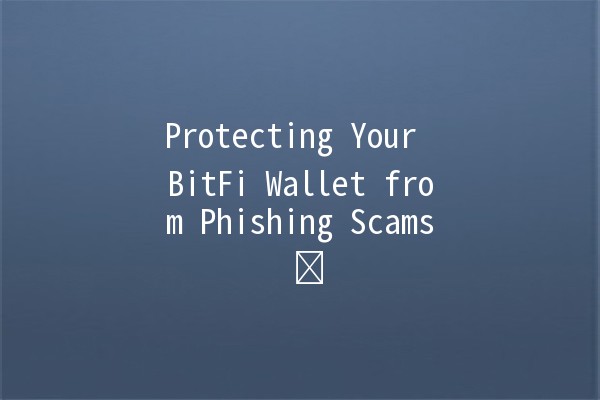
In the everevolving world of cryptocurrencies and digital finance, security is paramount. With the rise of hacking incidents and phishing scams, understanding how to safeguard your digital assets is crucial. This article focuses on effective strategies and practical advice for protecting your BitFi wallet from phishing scams.
Understanding Phishing Scams
Phishing scams are deceptive tactics used by cybercriminals to trick individuals into providing sensitive information, such as passwords and private keys. These scams can occur via email, social media, or even fake websites that closely resemble legitimate services. Recognizing the characteristics of phishing attempts is the first step toward safeguarding your digital assets.

Common Types of Phishing Attacks
Understanding these methods equips you to better protect your BitFi wallet.
Essential Tips for Protecting Your BitFi Wallet
TwoFactor Authentication adds an additional layer of security to your account. It requires not only your password but also a second verification step, such as a temporary code sent to your mobile device. By enabling 2FA on your BitFi wallet and associated accounts, you greatly reduce the chances of unauthorized access.
Example: Setting Up 2FA
To set up 2FA, navigate to your BitFi wallet settings. Look for the security section and follow the prompts to link your mobile device or authentication app. Ensure you store backup codes securely in case you lose access to your device.
Keeping your operating system, wallet application, and antivirus software updated is essential in defending against phishing attacks. Updates often include patches for security vulnerabilities that could be exploited by attackers.
Example: Automatic Updates
Enable automatic updates on your devices to receive the latest security patches without delays. If automatic updates are not available, schedule regular checkins to manually update your software.
Before clicking on any link, especially those received via email or messages, hover over the link to view the actual URL. Ensure that it directs to a legitimate and secure website (look for ‘https://’ and a padlock icon).
Example: Identifying Fraudulent Links
If you receive an email claiming to be from BitFi, instead of clicking the link, visit the BitFi website directly by typing the URL into your browser. This way, you can bypass any malicious redirects.
Avoid sharing sensitive information, such as your private key or recovery phrases, over email or messaging platforms. Legitimate services will never ask for this information via these mediums.
Example: Secure Communication
If you need to communicate sensitive information, use encrypted messaging apps or tools specifically designed for secure communications. Always verify the identity of the person you are communicating with.
Understanding social engineering techniques can help you recognize and avoid phishing attempts. Criminals often exploit emotions, urgency, or curiosity to manipulate their victims.
Example: Recognizing Manipulative Tactics
Be wary of emails or messages that create a sense of urgency, such as a threat to your account, or those that promise rewards for immediate action. Take a moment to analyze the situation before responding.
Frequently Asked Questions
What are the signs of a phishing attempt?
Phishing attempts often exhibit certain signs, such as poor grammar, unfamiliar sender addresses, requests for personal information, and generic greetings. Always be skeptical of unsolicited messages asking for sensitive details.
How can I recover my BitFi wallet if I fall victim to phishing?
If you suspect your account has been compromised, immediately change your password and enable 2FA if it's not already activated. Check for unauthorized transactions and reach out to BitFi customer support for further assistance in securing your account.
Is it safe to use public WiFi for accessing my BitFi wallet?
Public WiFi can be risky for accessing sensitive accounts, as cybercriminals can intercept data on unsecured networks. Use a Virtual Private Network (VPN) when accessing your wallet on public WiFi to enhance security.
What should I do if I accidentally clicked on a phishing link?
If you clicked a phishing link, change your passwords immediately and monitor your accounts for unusual activity. Run a security scan on your device and consider resetting your device to factory settings if vulnerabilities are detected.
Can I test my skills against phishing attempts?
Yes, many organizations offer phishing simulation tools that allow users to test their ability to recognize phishing attempts. Participating in these simulations can sharpen your skills and prepare you for realworld scenarios.
How do I report a phishing attempt?
Phishing attempts can be reported to your email provider, the legitimate service being impersonated, or cybersecurity organizations that track and monitor such activities. Reporting helps to create awareness and prevent others from falling victim.
Being proactive and wellinformed is your first line of defense against phishing scams. By following the strategies outlined above and staying updated on the latest security threats, you can significantly protect your BitFi wallet and secure your digital assets.

